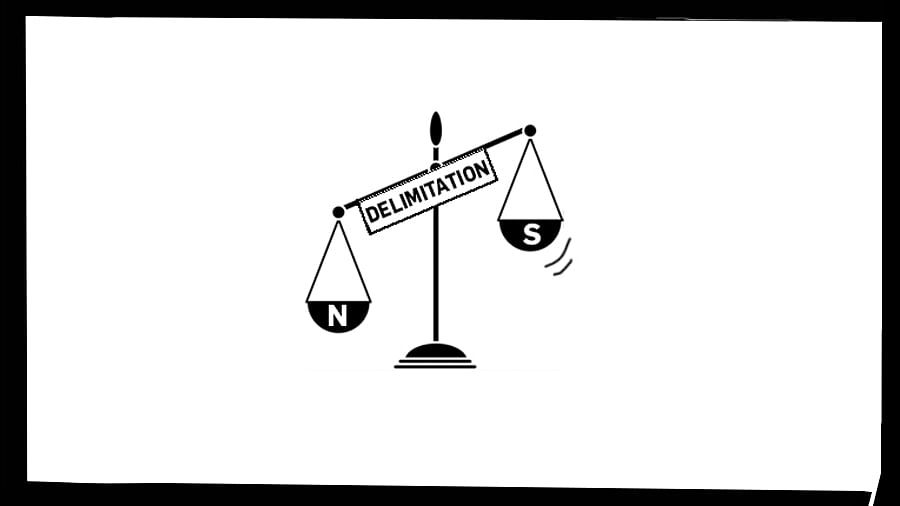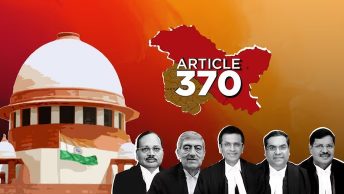Summary: In this explainer, we explore the intricacies of delimitation in India, in light of the upcoming 2026 census exercise. The question has gotten more complex with the expansion of reserved seats, most recently with the inclusion of seats for women. To ensure that the democratic principle is upheld in the process, judicial review as a veto mechanism is also addressed in the Indian context.
Delimitation has been making recent headlines, fueled by events shaping the contemporary political landscape. The Constitution (One Hundred And Sixth Amendment) Act, 2023, guaranteeing women’s reservation in Parliament, is an initiation of reforms that will materialize after the next census and subsequent delimitation process in 2026. Notably, the last delimitation exercise took place in the year 2002. In addition, a recent survey conducted by the Bihar government on caste dynamics has reignited attention on representation post-delimitation in India.
What is Delimitation?
Delimitation is the process of fixing territorial constituency boundaries in a country or province with a legislative body, involving the drawing or redrawing of electoral boundaries to achieve equal representation based on population changes. The constitutional foundation of delimitation lies in Articles 81, 82, and 170 of the Constitution of India.
Article 81 of the Constitution of India, predating the Forty-second Amendment, outlined the composition of the Lok Sabha with a maximum limit of 550 members. Clause (2) emphasizes proportionality, ensuring a ratio between the assigned seats for each state and its population. The term “population”, as per clause (3), was defined based on the latest census results. This provision triggered concerns due to ongoing family planning policies, leading to the Constitution (Forty-second Amendment) Act in 1976, freezing the population figure at 54.81 crores based on the 1971 Census until the first post-2000 census figures were available, later extended to 2026. During that period, the government pointed to “family-planning policies” as the rationale for this suspension. The stated objective was to prevent the potential disadvantage to states with effective population control measures, fearing a decline in their representation in the Lok Sabha relative to the states with larger populations.
Article 82 of the Indian Constitution addresses the readjustment of House of the People seats following each census. It empowers Parliament to determine the authority and method for this readjustment. The readjustment does not impact representation until the existing House is dissolved. Provisos include specifying the effective date through a presidential order, allowing elections based on existing constituencies until readjustment, and exempting readjustment until the first census after 2026 is published.
Typically, the Delimitation Commission is in charge of this exercise. Appointed by the President, it follows the guidelines set by the Constitution and the Delimitation Act of the specified year. For this purpose, it also works in collaboration with the Election Commission, to ensure a fair and representative distribution of electoral seats, following the evolving demographic landscape of the country.
Article 170 of the Constitution outlines the composition of state Legislative Assemblies with a minimum of 60 and a maximum of 500 members. Constituency delimitation and seat distribution remain grounded in the most recent census statistics, aiming for proportionality and the principle of “one person, one vote.” Amendments in 1956, removing the scale of representation, established fixed maximum and minimum member counts at 500 and 60, respectively, with states divided into territorial constituencies.
However, a shift occurred in 2002 with the approval of the Constitution (Eighty-fourth Amendment) Act, 2001, which altered Articles 82 and 170. Presently, the demarcation of constituencies remains unchanged until the census post-2026. During discussions on the Women’s Reservation Bill 2023 [The Constitution (One Hundred Twenty-Eighth Amendment) Bill, 2023] in the Special Session of Parliament, the Government noted that work on the census would begin post the 2024 Lok Sabha elections. Given the potential two-year duration for the Census process, with house listing in 2024 and enumeration in 2025, updated population figures may not be available before 2027. The process might extend to 2031 or further, considering the previous delimitation exercise spanned nearly six years. This extended timeline for census completion underscores the challenges in ensuring accurate representation and addressing demographic shifts. In the context of specific states, delimitation for Assam, Arunachal Pradesh, Nagaland, and Manipur faced delays due to exceptional security concerns. Jammu and Kashmir, split into two Union Territories in 2019, underwent delimitation in 2020. Assam recently completed its delimitation, redrawing 19 Assembly seats and one Lok Sabha seat. Although no new parliamentary or assembly constituencies were added, the state gained four additional SC and ST Assembly seats and one extra reserved Lok Sabha seat. Assam’s delimitation relied on the 2001 Census, potentially leading to uneven representation and inaccuracies in accounting for population growth and minority representation. The Union intends to explore delimitation in Arunachal Pradesh and Nagaland, while ongoing ethnic conflicts make delimitation in Manipur unlikely.
Challenges surrounding Delimitation
Delimitation is an arduous exercise involving delicate political and social considerations in a representative federal democracy like India. The delimitation exercise in India encounters significant methodological challenges, demography, and reservation-related challenges.
When confronting methodological challenges, the primary concern lies in selecting an appropriate method for allocating state seats, a decision that profoundly shapes the overall fairness of political representation. Secondly, meticulous redrawing of electoral boundaries is indispensable to thwart gerrymandering, the deliberate manipulation of district lines to unfairly favor a particular political faction. This unethical practice compromises the fairness of elections and undermines democratic principles governing representative systems. Lastly, the delimitation process demands a delicate balance in adjusting constituency populations, ensuring alignment with legal and constitutional mandates to uphold fairness and representativeness in elections.
The delimitation process faces a notable challenge related to the demographic dynamics of Indian states. The use of outdated population data for seat allocation is a significant concern. Article 81 provides guidelines for determining constituency size based on population, but relying on obsolete data can result in a misalignment between political representation and actual demographic distribution.
The case of Uttar Pradesh (“UP”) illustrates the significant impact of demographic changes on seat allocation. In the 1971 Census, UP’s population was 8.8 crore. Current seat allocation is based on this data. However, projections from the Ministry of Health and Family Welfare estimate UP’s population to be 23.1 crore in 2021. If the 2021 data forms the basis for the next delimitation, UP could gain additional Lok Sabha seats due to its population growth. Besides Uttar Pradesh, other northern states like Bihar, Madhya Pradesh, Maharashtra, and Rajasthan are expected to witness a significant increase in their Lok Sabha seats. Kerala, with its controlled population growth, stands out as a case where the number of Lok Sabha seats is expected to decrease.
Regional disparities further complicate the delimitation challenge, as illustrated by the case of Karnataka, particularly Bengaluru. Despite being a significant demographic hub, Bengaluru faces underrepresentation in the Lok Sabha and the state legislative assembly. The discrepancy becomes more pronounced when considering the city’s substantial population growth compared to the overall state growth.
The constitutional basis for reservation in elections lies in Articles 330 and 332 of the Constitution of India. Article 330, coupled with Section 3 of the Representation of Peoples Act, 1950, allocates seats in the Lok Sabha for Scheduled Castes (“SC”) and Scheduled Tribes (“ST”) based on their proportion to the total population of the respective states. This ensures representation for these communities at the national level. Article 332 deals with reserving seats for SCs and STs in the Legislative Assemblies of the States. The Constitution (Fifty-first Amendment) Act, 1984, brought changes to Article 332, permitting reservations for STs in the Lok Sabha and Legislative Assemblies of Nagaland, Meghalaya, Mizoram, and Arunachal Pradesh.
The Bihar caste survey indicates a significant rise in the SC and ST populations compared to the 2011 Census. With 19.65% belonging to SC and 1.68% to ST, potential underrepresentation in political seats is highlighted, suggesting that, according to constitutional mandates, Bihar should have seven to eight reserved seats for SCs and at least four for STs in Lok Sabha and Vidhan Sabha. The absence of the 2021 Census data poses challenges in assessing the nationwide impact, emphasizing the immediate need for a comprehensive census to fulfill constitutional obligations outlined in Article 330.
Similarly, the intersection of delimitation and reservation, as proposed by the Constitution (One Hundred And Sixth Amendment) Act, 2023, reflects a strategic alignment in addressing gender disparities in political representation. The inclusion of Articles 330A, 332A, and 334A underscores the comprehensive approach to women’s reservation in the Lok Sabha and state assemblies. Article 334A specifically outlines that the implementation of women’s reservation is contingent upon completing a delimitation exercise, emphasizing the nuanced connection between electoral constituency adjustments and achieving gender parity in political leadership. In light of the NALSA v. Union of India (2014) judgment recognizing transgender individuals as the third gender, the upcoming delimitation process raises questions about the political representation of transgender. As electoral boundaries are redefined, policymakers must address this question, contemplating measures such as seat reservations and affirmative action to ensure the effective inclusion of the third gender in political leadership.
Delimitation and Judicial Review
In the evolving landscape of democratic governance, the process of delimitation can either reinforce the foundational principles of equitable representation or serve as a tool for partisan manipulation.
In a hypothetical democratic regime, consider that a state undergoes significant demographic shifts due to population boom, urbanization, and migration patterns. The ruling party manipulates the Delimitation Commission to redraw boundaries, concentrating their electoral stronghold while diminishing opposition support. This disproportionately impacts minority communities, prompting citizens, particularly from marginalized groups, to seek judicial intervention. In this scenario, judicial review is indispensable to impartially assess the fairness of delimitation, prevent partisan abuse, and uphold constitutional principles of equitable representation and the protection of citizens’ political rights. Allegations of gerrymandering and a lack of transparency underscore the pressing need for judicial review. This illustrates the critical role of judicial review in preserving the integrity of the electoral system in the face of potential manipulation that threatens democratic representation.
During the constitutional debates, Sardar Hukam Singh warned the Constituent Assembly about the critical nature of delimitation (expected to be done by the Election Commission). The Constituent Assembly Debates and parliamentary proceedings of India’s first Lok Sabha indicate concerns about the potential sway of powerful political factions and the executive in delimitation. Still, there was no contemplation of judicial review. A conscious attempt was made to keep the courts out of the process, gaining considerable approval. Nevertheless, the rationale for this choice was not explicitly articulated.
In the landmark case Meghraj Kothari v. Delimitation Commission & Ors, a 1967 judgment by a 5-judge Constitution bench articulated the Supreme Court’s rationale for excluding courts from the delimitation process. The court opined that deeming orders under Sections 8 and 9 of the Delimitation Act as non-final could potentially lead to an undesirable scenario where any voter, at their discretion, could indefinitely obstruct an election by challenging constituency delimitation through successive court proceedings. This concern about election stalling through litigation raises questions about whether the fear of such delays should outweigh the protection of political rights, particularly minority groups negatively impacted by a delimitation strategy designed to diminish their political agency.
Turning to international comparisons, the United Kingdom conducts delimitation through independent Boundary Commissions, with courts generally avoiding interference. However, in the case of R v Boundary Commission for England (1983), the court asserted its authority to intervene if institutions engaged in the delimitation process wielded arbitrary power, emphasizing the defense of ordinary citizens. In the United States, where gerrymandering is recognized, courts actively address it. The precedent-setting case Shaw v. Reno (1993) affirmed the court’s role in challenging racially inexplicable electoral district boundaries as potential violations of the equal protection clause.
Way forward
While recognizing that redrawing boundaries is mainly the purview of the legislature and executive, courts in certain jurisdictions have proactively intervened when gerrymandering infringes on citizens’ rights. This reflects an acknowledgment of the nuanced balance between the electoral processes’ authority and the protection of fundamental freedoms. Indian courts could adopt a proactive approach to address gerrymandering and uphold citizens’ rights within the electoral framework.
Immediate action on the part of the government is necessary to prevent further delay in Delimitation and preserve the integrity of the electoral system. Initiating the delimitation process in India is paramount to safeguard democratic principles. The success of this upcoming exercise, after the 2024 elections, hinges on the responsible conduct of officials, the maturity displayed by political parties, and an informed electorate cognizant of contemporary political challenges. While ensuring reservation aligns with census and caste representation, due consideration must be given to the interests of South Indian states, reflecting ground realities. However, any regional emphasis should not compromise the core democratic principle of one man, one vote. Striking this balance is imperative for a fair and transparent delimitation process that upholds the foundational values of Indian democracy.
[Ed Note: This Article has been edited by Archita Satish and published by Harshitha Adari from the Student Editorial Team.]





Your blog stands out in a sea of generic and formulaic content Your unique voice and perspective are what keep me coming back for more
very informative articles or reviews at this time.
Kes – Mak Bahçe Aksesuarları ve Yedek Parça | Malatya kesmak, kes-mak malatya, malatya kes-mak, motorlu testere yedek parça,Malatya Stihl Bayi, benzinli testere yedek parça, testere zinciri, ağaç kesme pala, klavuz, elektronik bobin, hava filtresi, stihl malatya bayi, stihlmalatya,malatyastihl,stihl malatya servis,
Perpa Kameram | Güvenlik Kameraları gizli kamera, kamera sistemleri, güvenlik sistemleri
Looking forward to your next post. Keep up the good work!
very informative articles or reviews at this time.
This is really interesting, You’re a very skilled blogger. I’ve joined your feed and look forward to seeking more of your magnificent post. Also, I’ve shared your site in my social networks!
Nice post. I learn something totally new and challenging on websites